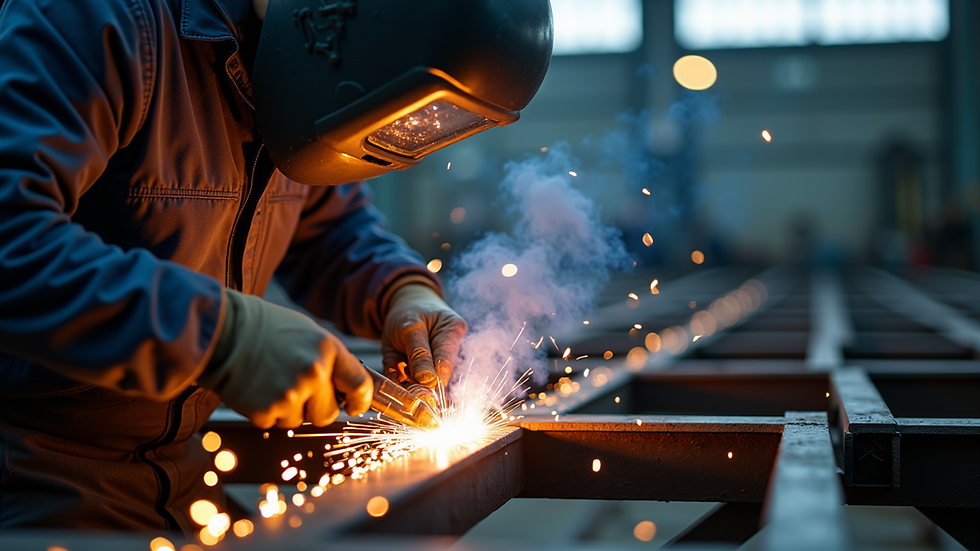Achieve Excellence with High-Quality Metal Fabrication
- JA Sims

- Aug 8
- 4 min read
Metal fabrication is a cornerstone of modern industry, shaping everything from towering skyscrapers to intricate machinery. Achieving excellence in this field requires precision, skill, and the use of advanced technology. Whether you are involved in construction, manufacturing, or custom design, understanding the essentials of top-notch metal fabrication can elevate your projects and ensure durability and aesthetic appeal.
Metal fabrication involves cutting, bending, and assembling metal structures. The process demands attention to detail and adherence to strict quality standards. When done right, it results in products that are not only strong but also visually impressive. This article explores the key aspects of metal fabrication, the benefits of choosing quality services, and insights into career opportunities within the industry.
The Importance of Top-Notch Metal Fabrication
Top-notch metal fabrication is essential for creating components that meet exact specifications and withstand demanding conditions. The quality of fabrication directly impacts the safety, functionality, and longevity of the final product. For example, in the automotive industry, precision metal parts ensure vehicle safety and performance. In architecture, well-fabricated metal frameworks support structural integrity and design innovation.
Choosing a reputable metal fabrication service means investing in:
Durability: Properly fabricated metal resists wear, corrosion, and environmental damage.
Accuracy: Precision cutting and welding ensure parts fit perfectly, reducing assembly errors.
Customization: Skilled fabricators can tailor designs to unique project requirements.
Efficiency: Advanced machinery and experienced technicians speed up production without sacrificing quality.
By prioritizing top-notch metal fabrication, businesses can reduce maintenance costs and enhance customer satisfaction.

Techniques and Technologies in Top-Notch Metal Fabrication
Modern metal fabrication combines traditional craftsmanship with cutting-edge technology. Understanding the common techniques and tools used can help you appreciate the complexity and skill involved.
Cutting
Metal cutting is the first step in shaping raw materials. Techniques include:
Laser Cutting: Uses a focused laser beam for precise cuts with minimal waste.
Plasma Cutting: Employs ionized gas to cut through thick metals quickly.
Waterjet Cutting: Utilizes high-pressure water mixed with abrasive particles for clean cuts without heat distortion.
Bending and Forming
After cutting, metal sheets or bars are bent into desired shapes using:
Press Brakes: Machines that apply force to bend metal at specific angles.
Roll Bending: Rolls metal into curves or cylinders.
Stamping: Uses dies to form complex shapes through pressing.
Welding and Assembly
Joining metal parts requires skillful welding techniques such as:
MIG Welding: Uses a continuous wire feed for fast, strong welds.
TIG Welding: Provides precise control for thin or delicate metals.
Spot Welding: Joins overlapping sheets with localized heat.
Finishing
Finishing processes improve appearance and protect metal surfaces:
Powder Coating: Applies a durable, colorful finish.
Galvanizing: Adds a protective zinc layer to prevent rust.
Polishing: Creates a smooth, reflective surface.
Investing in advanced equipment and skilled operators ensures that each step meets the highest standards.

What is the Highest Paying Job in Fabrication?
The metal fabrication industry offers a variety of career paths, some of which are highly lucrative. Among these, fabrication engineers and welding inspectors often command the highest salaries due to their expertise and responsibility levels.
Fabrication Engineer
Fabrication engineers design and oversee the manufacturing process. They ensure that metal parts meet design specifications and comply with safety standards. Their role involves:
Creating detailed fabrication plans.
Selecting appropriate materials and techniques.
Coordinating with production teams.
Troubleshooting fabrication issues.
Because of their technical knowledge and leadership role, fabrication engineers typically earn salaries well above the industry average.
Welding Inspector
Welding inspectors assess the quality of welds to ensure structural integrity. They use non-destructive testing methods such as X-rays and ultrasonic testing. Their responsibilities include:
Inspecting welds for defects.
Verifying compliance with codes and standards.
Documenting inspection results.
Recommending corrective actions.
Due to the critical nature of their work, welding inspectors are highly valued and well compensated.
Other High-Paying Roles
Project Managers: Oversee entire fabrication projects, managing budgets and timelines.
CNC Programmers: Write and optimize programs for automated cutting and forming machines.
Metal Fabrication Supervisors: Lead teams and ensure production efficiency.
Pursuing certifications and gaining experience in these roles can significantly boost earning potential.

How to Choose a Metal Fabrication Partner
Selecting the right metal fabrication partner is crucial for project success. Here are practical tips to guide your decision:
Evaluate Experience and Expertise: Look for companies with a proven track record in your industry.
Check Equipment and Technology: Ensure they use modern machinery capable of handling your project’s complexity.
Review Quality Certifications: Certifications like ISO 9001 indicate commitment to quality management.
Ask for References and Samples: Request examples of past work and client testimonials.
Consider Turnaround Time: Confirm that the fabricator can meet your deadlines without compromising quality.
Assess Customer Service: Responsive communication and problem-solving skills are essential.
By carefully vetting potential partners, you can avoid costly delays and ensure your project meets expectations.
Enhancing Your Projects with High-Quality Metal Fabrication
Incorporating high-quality metal fabrication into your projects can transform ideas into reality with precision and durability. Whether you need custom metal parts for industrial machinery or architectural elements, working with experts ensures superior results.
Benefits of choosing high-quality fabrication include:
Improved Safety: Stronger, well-made components reduce risk of failure.
Aesthetic Appeal: Clean finishes and accurate shapes enhance visual impact.
Cost Savings: Fewer errors and reworks lower overall expenses.
Sustainability: Efficient processes minimize material waste.
Investing in quality fabrication is an investment in the longevity and success of your projects.
Achieving excellence in metal fabrication requires a blend of skilled craftsmanship, advanced technology, and strategic partnerships. By understanding the processes, career opportunities, and selection criteria, you can make informed decisions that lead to outstanding results. Whether you are managing a large-scale construction project or developing custom metal products, prioritizing top-notch metal fabrication will set your work apart in quality and reliability.






Comments